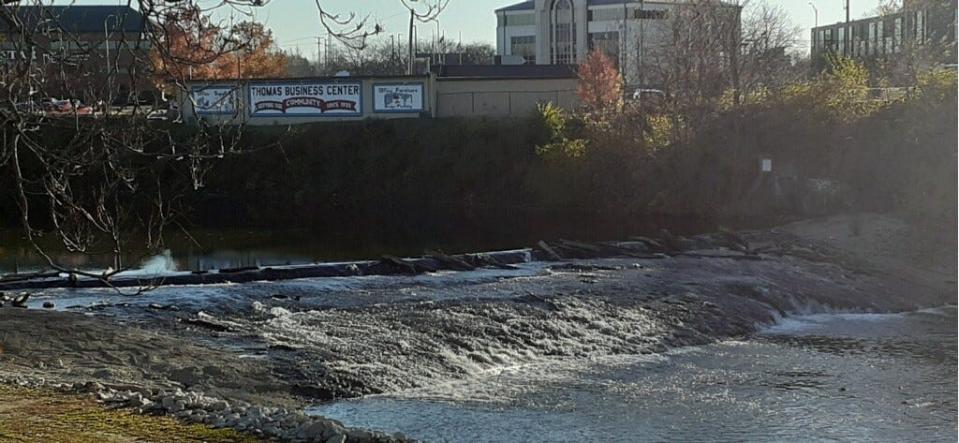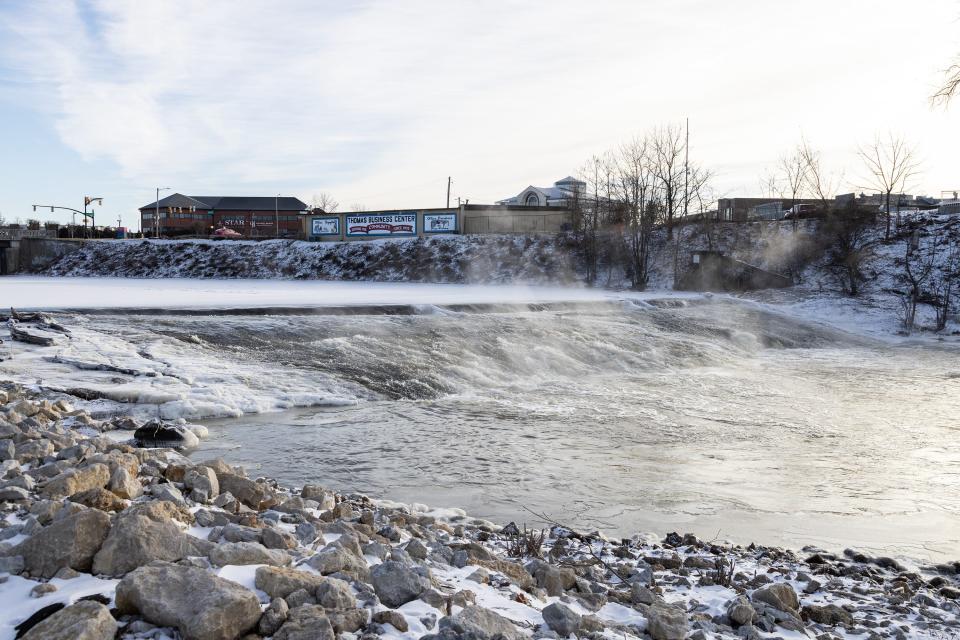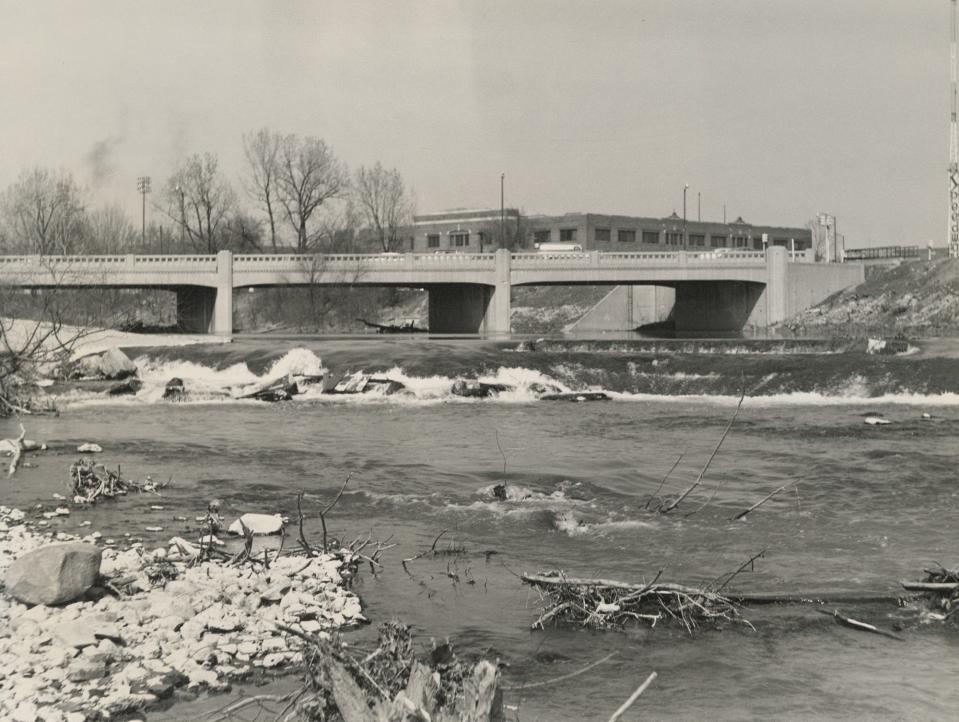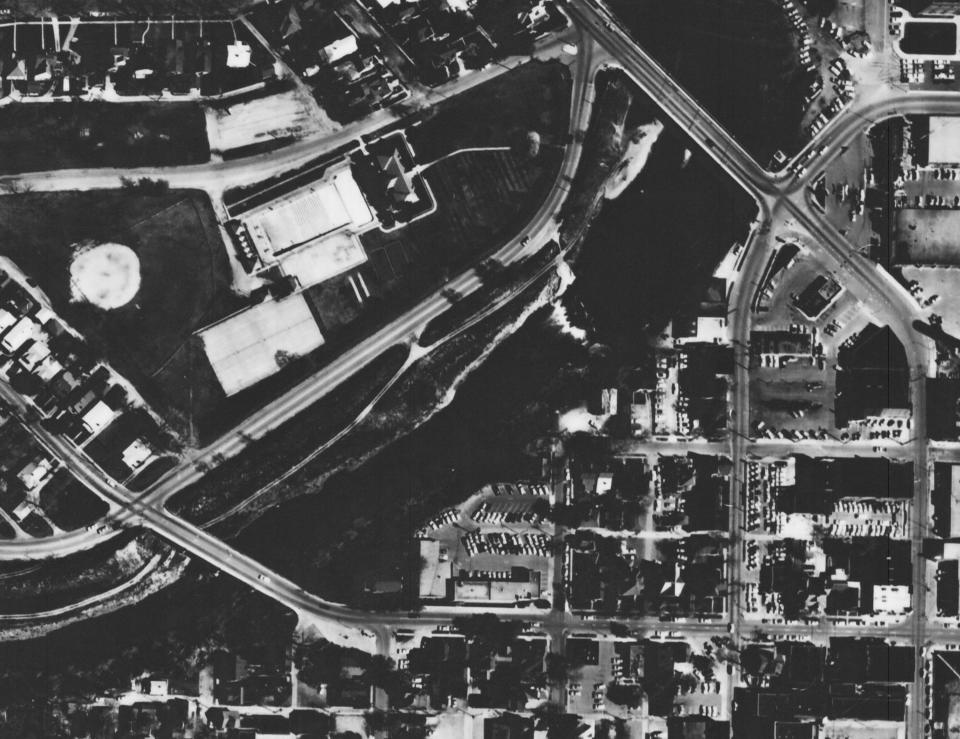ByGone Muncie: It's time to return the White River to nature by removing High Street dam
In November you might have read in The Star Press about a feasibility study regarding the future of the High Street Dam. It’s deteriorating, which poses a dilemma for our community — should we fix or demolish it?
The study was a joint effort between FlatLand Resources, Delaware County Soil and Water Conservation, and the Indiana Department of Natural Resources to evaluate whether to partially or fully remove the dam.
For any non-local readers, the High Street Dam lies downriver about 400 feet from Fallen Heroes Memorial Bridge near Tuhey Park. The span serves as a termination point for High Street at a busy intersection with White River Boulevard, Wheeling Avenue, North Street, and the White River Greenway. Thousands of Munsonians and scores of Canada geese pass this crossing daily within sight of the dam.

Most of the dam we see today was built by the city of Muncie in the early 1960s. The project was a beautification effort to raise the water level back through the riverbend. It was constructed over an older dam originally installed by Indiana General Service Corp. about 1910. A subsidiary of American Gas and Electric (now AEP), Indiana General Service Corp. produced electrical power and steam heat at a plant where city hall is today.
The original dam was designed to raise the White River’s water level “for the intake of the power company’s plant boilers,” according to the Muncie Star. The intake pipe lay immediately southeast of the bridge.
The High Street Dam was controversial from the start, mostly because it caused putrid stagnation. Prior to the opening of Muncie’s Water Pollution Control Facility in 1941, city sewers emptied into the White River. For some unknown, stupid reason, Indiana General Service Corp. installed their intake 150 feet downriver from the 1879 High Street Sewer outlet. In dry months, the power company pulled so much water out of the river that it ceased to flow over the dam. Yet sewage continued to discharge, rendering a stagnant pool under the bridge and back along Wheeling.

The situation was so bad that in early March of 1923, City Councilor Roy Friedley proposed a resolution calling to remove the dam. The council instead formed a committee to investigate, but nothing ever came from it.
Stagnant sewage continued to form behind the dam throughout the 1920s. In 1926, Muncie’s Health Officer Dr. Earl Green was quoted in the Star calling for “some adequate method of sewage disposal for the preservation of city health.” The immediate concern was “the sluggish state of the river near High street bridge where its flow is checked by a dam.” Still, nothing happened.
Once again in 1931, the council voted to explore the dam removal.
Councilor Ora Shroyer was quoted in the Evening Press, calling the dam “a gigantic cesspool right at the mouth of one of our sewers.” But still, nothing happened.

In 1932, Carey Taughinbaugh, a city attorney in Mayor George Dale’s administration, “announced that he had served an order to the Indiana General Service Company to remove the dam from the White River.” It’s not clear in the newspapers how Indiana General Service Corp. evaded the order, but they did and the dam remained.
A year later, in spring of 1933, a young Munsonian drowned upriver from the bridge. Volunteer searchers couldn’t locate her body because of the high water. An irate Taughinbaugh again issued “written demands on the Indiana General Service Company for removal of the dam in the White River immediately.” He also told a Star reporter that he couldn’t find any record showing “where the company obtained authority for construction” in the first place.
That was apparently enough pressure, because in June, the power company modified the dam. They actually raised it higher, but also installed a flood gate “so that the level of the river might be controlled.” Presumably if too much sewage built up behind the dam, the gate could open to send filthy water downstream (sorry Yorktown). The dam’s new height pooled water back to Queen Street.
Beginning in the late 1930s, the White River underwent a series of significant changes.
The city received federal Public Works Administration funding for a massive flood control project. They hired Works Progress Administration workers to lower, widen and straighten parts of the river channel. The project was completed in the 1940s when the U.S. Army Corps of Engineers built the levees.
WPA workers also built the city’s original interceptor sewer and treatment plant. When the system went online in 1941, most of Muncie’s sewage flowed directly to the Water Pollution Control Facility. The old High Street Sewer outlet was no more and everyone just forgot about the mess behind the dam.
So much so that in 1943, the Muncie Boat Club sought to build a bigger dam, “just west of the High Street bridge which would deepen the water sufficiently along Wheeling for the use of small boats.” This was never built, but six years later, the city did construct the George Dale Dam near McCulloch Park. Its purpose, according to the Star, was “for the beautification of White River” at a location “where local folks could spend a few hours in peaceful boating, bathing or fishing.”
Such river-raising dreams of leisure were nothing new. As early as the gas boom, some Munsonians advocated damming the river for aesthetic reasons and to accommodate steamboats.

In 1889, a Munsonian electrical engineer named Jack Stouder floated a kooky scheme to erect “a dam just north of the High street bridge to form a beautiful lake extending around the course of the river.” A new depth of 5 feet “would afford excellent boating, while small steamers could easily be run.” Such an attraction, according to Stouder, “would annually bring thousands to our beautiful city.”
Decades later, in the 1950s, the power company, known then as Indiana-Michigan Electric, ceased operations at its High Street plant. By 1960, much of its dam had washed away. In August of that year, Indiana-Michigan offered “the city the broken-down dam in the White River,” according to the Star.
Mayor H. Arthur Tuhey accepted and announced the city would repair the dam “as a step to beautify the river between that point and Walnut Street.” Indiana-Michigan funded most of the project. The dam was rebuilt taller to a height of 7 feet. It pooled water back in the bend all the way to Elm Street. Renovations were made just two years later.
The dam, however, didn’t then and doesn’t now serve any meaningful purpose. It only hurts the river’s ecosystem, which is indefensible in my opinion. Between the 1880s and 1970s, some of our forebears gleefully trashed the White River with reckless abandon. It’s high time to make history by returning our river back to as natural a state as possible.
Chris Flook is a Delaware County Historical Society board member and a Senior Lecturer of Media at Ball State University.
This article originally appeared on Lafayette Journal & Courier: Column argues Muncie's High Street dam serves no purpose

